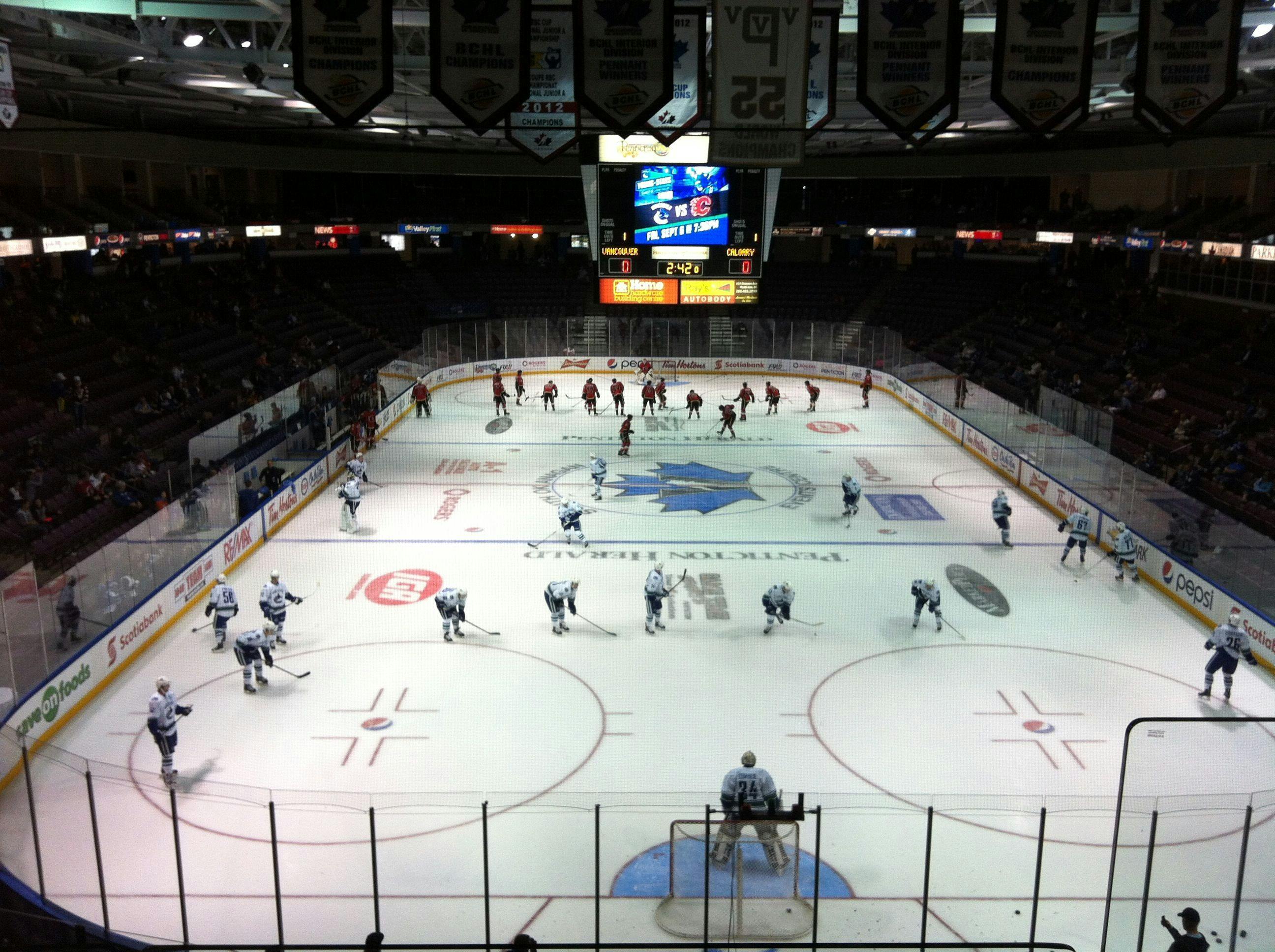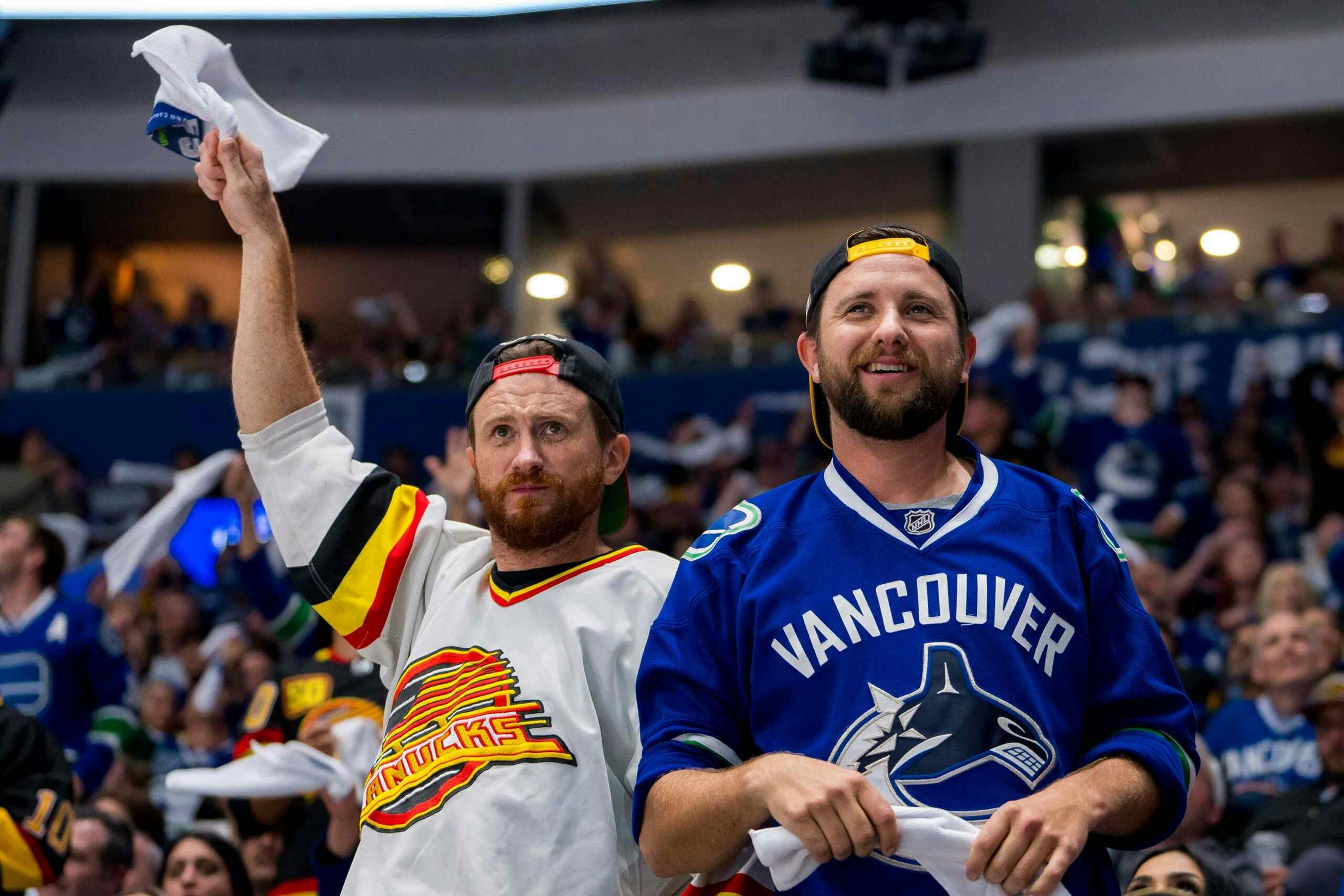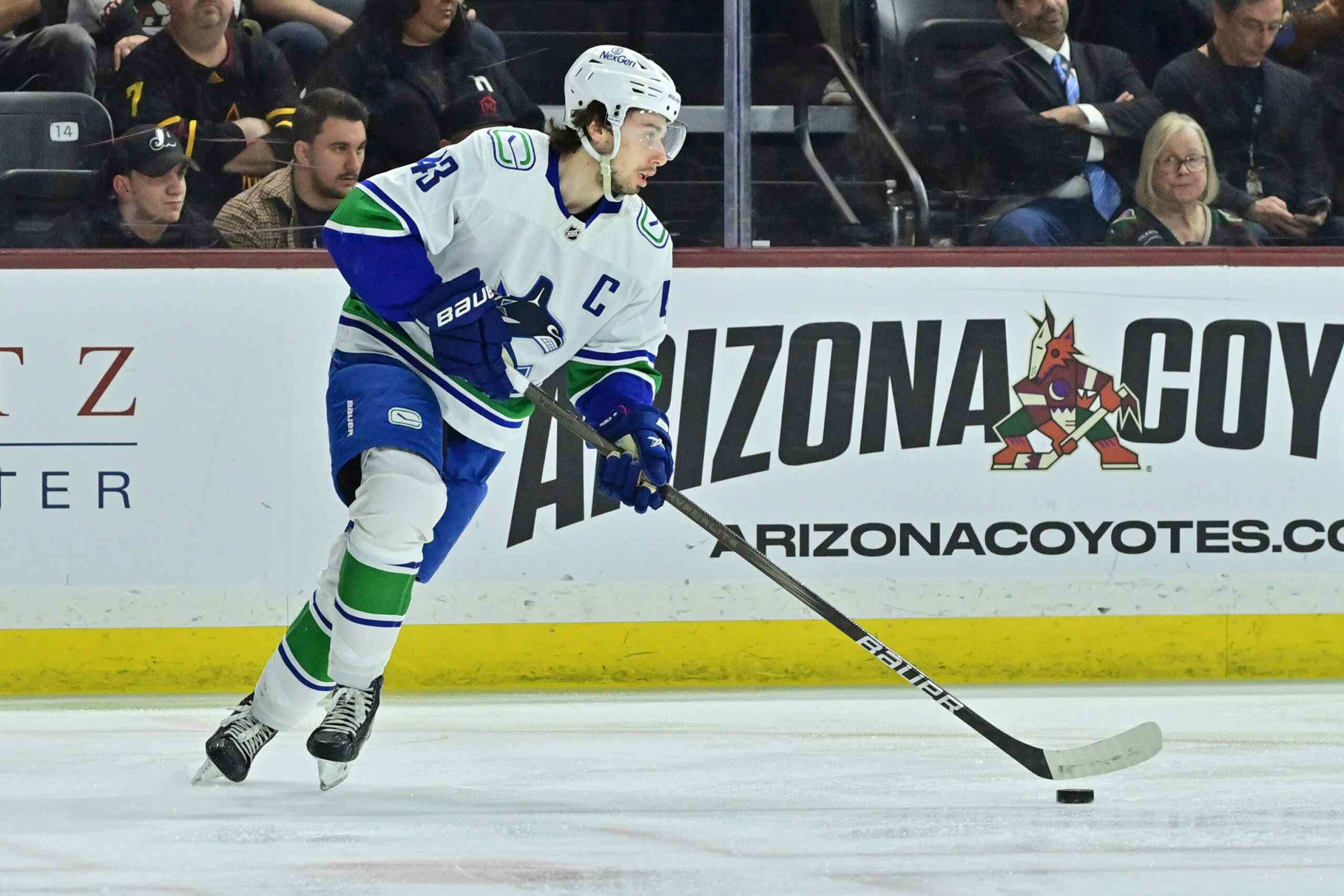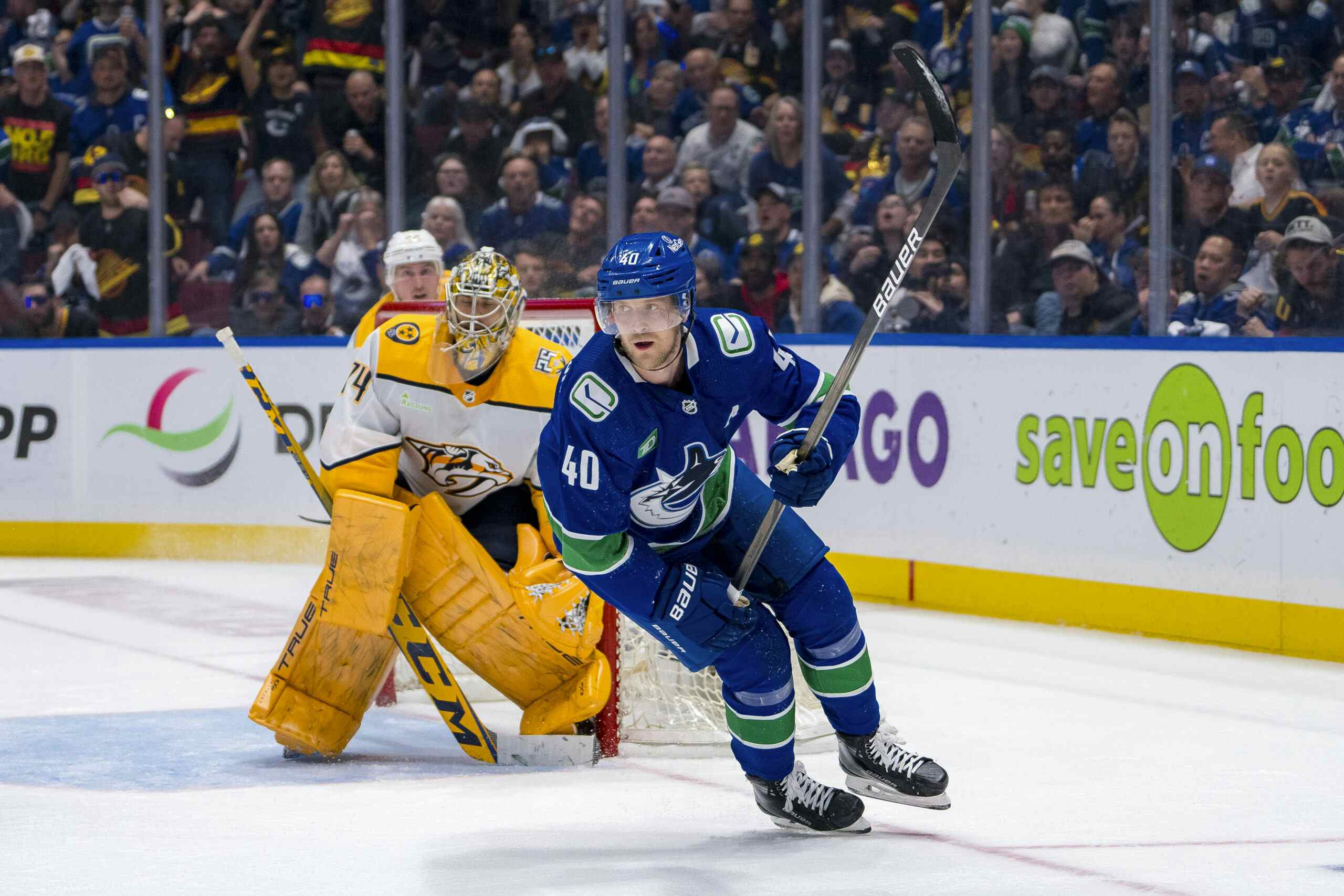Young Stars Tournament Day Two: Canucks vs the Mighty Groins of Ortio

The Nations Network sent some Jets Nation writers to the Young Stars Tournament in Penticton, BC. They’re judging your team and bringing you the view from the Press Box. In case you missed the recap of Game 1, it’s here.
Vancouver’s second game of the Young Stars tournament was a frustrating 4-1 loss to the talk-of-the-tournament Flames. In spite of controlling the pace for most of the game and firing 40 shots on Joni Ortio, the Canucks just couldn’t take control of the scoreboard. Below I’ll cover some of the tactics that are easier to see from the press box than your computer monitor, and review each player’s game.
The game as a whole was slower and less physical than the game against the Sharks. Vancouver iced a better defense group against a better Flames team and out-shot the Flames 40-31. Two questionable goals on Eriksson and a terrible play by Mitch Elliot, along with an outrageously good game by Joni Ortio, render the score a somewhat meaningless way to describe the game. Instead, the story of the game was the difference in systems play between the successful Vancouver squad and the woeful Edmonton team who played Calgary yesterday.
For starters, the Canucks centres did well to cover the slot where the Flames generated so much of their offense in game one. As well, Vancouver wingers collapsed deep, but stayed in the inside passing lane, negating the layered attack that Monahan and Poirier had used to dismantle Edmonton’s defense. In fact, Monahan had a quiet first period in part because he had to adjust to a much more contested offensive zone. While Monahan adjusted his game to take advantage of soft zones on the half-wall and along the top of the zone, Sven Baertschi was frustrated on almost every shift. His preference is for a low-to-high pass into the high slot as he floats in just off-centre, and then he toe-drags into a heavy wrister with a disguised release point. The Canucks made passing to that area almost impossible with a defenceman overload that put one defender after the puck, a second defender on the strong side at the goal line, the centre at the low circle, and the strong side winger off the boards parallel to the face-off dot.
The Canucks also excelled on the powerplay, where they used an umbrella that folded into an overload and then back out to an umbrella. That can be hard to imagine in words, but try to picture when the Canucks had all of their players on one side of the ice. The forwards form a triangle (middle slot, low slot, corner) while the D pair are parallel at the blue line, with one defenceman in a vertical line with the middle of the net (and two forwards) and the other along the boards. It forced the Flames box to fold into a line. When the play moved up the boards and then to the middle point, the puck carrier and the player in the middle slot would spread out to create the umbrella, while the defender who had been along the boards would take the top of the umbrella and receive a pass when in position. The Flames box would follow suit and spread out, leaving a massive shooting lane right down the middle with one forward in front and the forward from the corner driving the net as well.
The Flames eventually adjusted by moving to a tight diamond pattern, but the Canucks began attacking from the goal line and managed to draw Zach Davies into a walk-about to create a stretch of 3 or 4 high-quality chances in the first. Though only scoring one goal, the Canucks powerplay was much more sophisticated than other teams are using in this tournament, and also more dynamic.
But enough boring tactics. Let’s talk about the prospects themselves.
Defence/Goaltending
#75 Joacim Eriksson: Despite being called "Erik-sun Yokum" by the in-arena announcer to start the game, Eriksson had a solid 1st period. Picking up where he left off, his rebounds were well controlled and his movements precise and efficient. He fell back down to earth during the final 40 minutes and revealed a worrying trend, however. Goals 2 and 3 by Calgary were both seen clearly by Eriksson and they looked awfully similar to the Sharks’ second goal (point shot off the O-zone face off) one night previous. In his defence, the powerplay goal by Eric Roy (#84) may have been tipped by Shinkaruk on the way in and the shot by Ramage was well placed, just under the bar on the far side. Still, Eriksson showed more in fighting traffic and tracking rebounds than he did on those clean chances. Could it be as simple as struggling with the angles on smaller ice?
#26 Frank Corrado: Corrado was a very welcomed, steadying presence for the Canucks blueline. Though he and partner Miles Liberati were -1 in the contest, their defensive zone coverage showed patience and awareness. Corrado moved the puck well in transition and aside from a few shaky moments with the puck early in the game, looked like a confident puck distributor. He faced the Flames’ best and it actually helped Subban as well for that reason. Not a world-beater at 20, but Corrado challenged Ramage for best defender in the game. On one play in the 1st, he crossed from RD to LW to support an offensive play and ended up the trigger man. Showed real situational awareness of how to help the play and who was available to get there. A goal was only a bonus in a game where his presence was noticeable almost every shift.
#43 Sacha Guimond: At one point I tweeted that he was an odd choice for the PP because of his turnover problems. Shortly after, he made the turn over that led to Poirier’s PK breakaway. I didn’t like his game against the Sharks and I wasn’t more impressed against the Flames. He was paired with Subban and I thought Subban did better than Andersson the previous night. Still, his offensive zone turnovers on soft plays with the puck caused a number of panic moments as Subban was often not there to cover. You can’t fault him for having a wild partner, but his decision making shows a lack of awareness for the context of his decisions. Luckily for him, the Canucks forwards did very well to pressure the puck in transition and Guimond avoided the 120ft chase of shame at even strength.
#60 Henrik Tommernes: Another poor outing to my eye. Tommernes made a number of costly give-aways and missed the net on a 20ft shot late in the first while the Canucks were pressing the advantage. He was in the box when Calgary scored their third goal.
#61 Evan McEneny: McEneny had the sort of game defencemen hate. His holding penalty came when his partner (Tommernes) made a bad neutral zone give away. He played a steady game, but managed to drag his pairing into barely-holding-on territory. It was an effortful blur of a game for McEneny.
#67 Jordan Subban: Subban was much more effective in this game than game 1. Corrado taking the toughest assignment helped, but also Subban played a more contained game. Early in the first he broke up a play with a stick in the passing lane when he might have been chasing the puck carrier in game one. Still, he was early to exit the zone often, and was burned on it on the Flames’ fourth goal. On one occassion, he carried the puck low in the offensive zone and then circled back to the wrong side and stood beside Guimond, who eventually switched sides. His skating is excellent, but he plays without much positional discipline, almost like a high-event rover.
#68 Miles Liberati: A very impressive outing for Liberati. Late in the 1st he shortened and softened a point shot to get it through traffic and onto the net. His lead passes were excellent and his gap control among the tightest on the Canucks blue line. He was focused in his defensive end and managed the Flames’ passing lanes well.
Forwards
#46 Niklas Jensen: Hey, this guy is pretty good, I think. Was the most dynamic forward for the Canucks and didn’t seem to slow down despite a drop in pace from game one to game two. He made a seeing-eye pass to Tommernes late in the first that showed good vision. He played in all three disciplines and in all three zones. He continues to make really effective contact and tracks the play well on the back check. His shot is very good as well, with a quick release and a lot of heat behind it. Jensen’s skating is extremely powerful, and he builds speed with his transition skating – a very rare skill at this level.
#48 Hunter Shinkaruk: It seemed Shinkaruk took a step back in this game. The Flames defence was perhaps slightly more talented and certainly better skaters than he faced against the Sharks. The Sharks, too, played with a short bench after Mueller and later Abeltshauser were hurt. Shinkaruk continued to be mean and a little dirty but didn’t draw the same ire. A few shifts with strong chances at the net, good movement on the powerplay, and still showed tremendous skating. Not as consistently dangerous, and his attack from behind the goal line was anticipated by Ortio each time. He struggled on the PK as well. One thing to note is that the Flames frequently put a shadow on Shinkaruk and no other player. Corban Knight drew the assignment frequently. Overall a solid game for #48, and only a let down in comparison to a thrilling performance in game one.
#52 Cole Cassels: After a very effective two-way game against the Sharks, Cassels saw elevated minutes against Calgary, playing with Jensen and Franson most of the game and earning PP time with Shinkaruk and Horvat. He continued to do what makes him successful – separating people from the puck with his body and attacking the net. He rarely slows down during the game and it gives his play a frenetic feel that belies the control with which he affects the play. Very effective two-way player in this tournament so far.
#53 Bo Horvat: To my eye, Horvat played limited minutes in the second period, and was used very sparingly after the Flames put away two goals early in the 3rd. He did continue to play PP time, but even missed a PK shift with Shinkaruk in the 3rd. Nevertheless, even in limited minutes Horvat made a difference. His cycle work with Shinkaruk is exceptional, his two-way play remained strong, and he generated chances with the man advantage. He managed 3 shots on net and was even in a game where the team was -2. The team missed him when he wasn’t out as no other Canucks centre showed his level of offence.
#56 Alex Friesen: Took over Cassels’s role from game 1, centering the checking line with Elliot/Blomstrand/Hall, and scrubbing the glass with the hairless faces of other teenagers. He was dogged in his pursuit of the puck and worked the offensive end-boards with zest. His speed was not out of place, and his transition skating was adequate. Didn’t show much in the way of puck skills but wasn’t a black hole either. One of two Canucks to not record a shot on net.
#58 Ludwig Blomstrand: Blomstrand managed three shots on net and is not afraid to sacrifice his body to make a play. That said, he doesn’t stand out to me. He’s an average skater for this level, which is an early knock for me from the press box, and though effortful and often involved in the play, rarely generates clean chances or intentional chaos. Strong player along the boards. Opportunistic, and can create the odd break through his determination. Please correct me if I’m missing something on him.
#64 Adam De Champlain: I noticed De Champlain for the second time in the game when he hit Kanzig uselessly in the third period and was late to the backcheck as a result. The first time I noticed him, he skated up the wing, dumped the puck, and then disappeared again. Had 2 shots. Was the third guy with Mallet and Maillet to start the game, but didn’t catch my eye enough to track his shifts.
#71 Mitch Elliot: A blunderous give away on the Monahan goal marred a reasonable game as the Jesse Mychan of game 2. For a huge bodied man (6’5"), he got up and down the ice well. Still, at 20 years old and with 4 points 63 WHL games last year, Elliot’s role is unfortunately obvious and he wasn’t doing it in this game.
#72 Zach Hall: Was given a more appropriate audition to start the game. Hall scored 81 points in the OHL last year and started the game with Horvat and Shinkaruk. But he got his -1 on the 3rd period Monahan goal while on with Elliot.
#74 Cain Franson: Not a very remarkable game to my eye. He made some hits, played on the PK in the first before it was scored on. Ended -1 with one shot on net and a 1st period penalty.
#77 Philippe Maillet: One of two players who didn’t manage a shot on net. I can claim a lack of bias on this player as I didn’t know the rap on him before I watched the game. But it turns out he lived up to it. The positive is that he clearly read the play at a high level and his anticipation was on display. The bad news is that he was afraid of contact, and did everything he could to avoid being on the boards. I suspect that’s a hard behaviour to notice until it becomes problematic, and there was a particular shift in the 2nd in which the Canucks were trying to exit the zone on his wing, and Mallet swung for the easy ladder pass, but Maillet just wouldn’t take the hit to make the play. After a few re-cycles to the corner, he actually tried to make a no-look breakout play from the faceoff dot facing his own goal line. Obviously, that was a give-away. Mallet finally stepped in to chip the puck out. He did show some puck skills in neutral zone transition, but seemed out of rhythm in the game. Appeared to have another skating gear he didn’t use.
#78 Alexandre Mallet: A disappointing follow-up to a very effective first game. Mallet was wearing an ‘A’ for the team but was much more one-dimensional in his play. He managed one dangerous offensive play to the low slot in the 3rd period, but was mostly seen hitting people or punching Ferland. He did continue to show impressive defensive sense for the game, and filled the Flames scoring areas well. He frustrated Monahan in the first by simply tracking him through the slot and interrupting the easy play he’d had open to him all game against the Oilers. A simple play by Mallet that showed awareness and experience.
*The Canucks play the Oilers at 2pm on Sunday afternoon.
Recent articles from Kevin McCartney





